Topics
Category
Era
Rural Electrification Administration in Minnesota
On May 11, 1935, President Franklin D. Roosevelt signed Executive Order 7037 to create the Rural Electrification Administration (REA), a New Deal public relief program. The program provided $1 million for federal loans to bring electric service to rural areas. It revolutionized life in rural Minnesota and across the country.
Before the REA, there were pockets of rural electric service around Minnesota. In 1914, farmers in Yellow Medicine County formed the Stony Run Light and Power Company, one of the first electric cooperatives in the country. By December of that year, twenty-six farms had power obtained from the Granite Falls central power station. Farmers on the line paid for all equipment, including poles, line, transformers, and meters, at a per-farm cost of $400 to $750. By 1921 the number of farms on the line grew to fifty. Annual fees ranged from $30 to $75, depending on power usage.
The Division of Agricultural Engineering at the University of Minnesota began a groundbreaking experiment in rural electrification in 1923. Known as the Red Wing Project, the program brought electricity to nine farms in Burnside Township near Red Wing and furnished electric agricultural and household equipment. Believed to be the first rural electrification project of its kind in the world, the study provided data on the impact of electricity on both farm economy and quality of life. Its success prompted twenty-three other states to conduct similar projects.
The 1930 census reported 185,255 farms in Minnesota with 895,349 people living on them. Of that number, 23,342 farm homes had gas or electric lighting. Most families used kerosene lanterns in the house and in outbuildings and lived without indoor plumbing. Even so, by 1934, 6.8 percent of Minnesota's farms had central station electrical service.
Commercial power companies showed reluctance to pursue rural customers due to the high cost of building power lines. They believed that rural electrification would not be profitable. Farms with central station service paid a high price for electricity. Average rates ranged from ten cents to fifteen cents, per kilowatt hour for lighting, and ten cents for farm power service, beyond the reach of many farm families in the Great Depression. As a result, less than 11 percent of American farms had electric service in 1935 compared with 90 percent of city residents.
U.S. Senator Henrik Shipstead of Minnesota understood his rural neighbors' desire for affordable electric service. He too wanted service for his cabin on Lake Irene in Douglas County and advocated in Washington for reasonable rates for rural customers in 1934. He gained the support of President Roosevelt, who created the Rural Electrification Administration. The new, temporary New Deal agency was tasked with distributing loans to meet the demand for electric service on farms.
The lack of support from commercial power companies prompted groups of farmers to work together to organize electric cooperatives. Each co-op's board of directors drew up articles of incorporation and bylaws and registered with the State of Minnesota. The REA encouraged the inclusion of women directors, but only Beltrami Electric Cooperative in Bemidji and Wild Rice Electric Cooperative in Mahnomen had female members on their original boards.
Once established, the co-ops applied for long-term loans from the REA. The funding covered the construction of generating plants, transmission lines, and wiring of homes and outbuildings. Farmers could use the money to purchase milking machines, cream separators, bale lifters, and other electric equipment and tools. The loans also covered the installation of indoor plumbing and the purchase of such labor-saving household items as refrigerators, washing machines, and electric irons.
In spite of these benefits, many farmers were reluctant to join a cooperative. At the height of the Great Depression, many could not afford the price of shares at two to five dollars each plus the monthly charge for electricity. Some worried that the government would hold them personally liable for the loan. Others lacked confidence in the relatively new technology or thought it unnecessary to their operations.
On September 13, 1935, the Meeker Cooperative Light and Power Association (MCLPA) became the first REA co-op organized in Minnesota. Nearly seven hundred farmers signed up at five dollars per share within twenty-seven days of incorporation. The following February the co-op received a $450,000 loan, and by November 28 of that year it powered up the first REA lines in the state. Taking a cue from an electrified farm project set up in the eastern United States, the MCLPA went on to establish a demonstration farm on the property of Charles Ness. Appliance and farm equipment manufacturers furnished sixty-seven pieces of equipment for the purpose of sharing the benefits of electricity with local farmers. The Ness family hosted 2,000 people at the farm during its grand opening on June 12, 1937. Within two years, more than 34,000 people had visited the farm from around the United States and abroad.
Another early Minnesota REA co-op, the Douglas County Cooperative Light and Power Association (later the Runestone Electric Association), was incorporated in November 1935. Farmers paid $2.50 per share to join. On July 1, 1936, the co-op received a $50,000 REA loan at 2 percent interest to build fifty-six miles of power lines. Electricity reached the first forty-five farms – and Senator Shipstead's cottage – in September 1937.
The initial success of the program prompted Congress to pass the Rural Electrification Act on May 20, 1936. This measure made the REA a permanent agency. Three years later the REA became part of the Department of Agriculture.
By 1939 the cost to construct one mile of rural power line dropped from about $2,000 to $600, spurring the rapid expansion of rural electrification. The 1940 U.S. Agricultural Census reported that 30 percent of farms in Minnesota had electricity. Just five years later, that number grew to 79.7 percent. The Census Bureau stopped including statistics on farms with electricity in 1959, and by 1963, 99 percent of all farms in the United States reportedly had power.
Rural electrification has had a huge impact on Minnesota's farm economy and the rural standard of living. Electricity found many uses on farms that helped to increase productivity, raise farm income, and boost the local economy. Electric motors drove milking machines, making it easier for farmers to manage larger herds and increase milk production. Motor-powered pumps enabled irrigation, which helped to increase crop yields and encouraged crop diversification. Electric lighting improved poultry operations by contributing to a significant increase in egg production. Better illumination on the farm helped to prevent accidents.
Farm families enjoyed more leisure time and physical comfort. Electric lighting made it possible to read, sew, and do other activities at night. Brighter light helped to prevent eyestrain and had a positive effect on residents' mental health. Indoor plumbing with hot and cold running water saved time spent hauling water from a hand pump and eliminated cold, dark trips to an outhouse. Electric ranges meant less time spent chopping wood. Electric refrigeration ended the need for cutting and hauling ice and provided safer food storage. Clothes washers and electric irons made laundry day less labor-intensive. Electric radios and telephones connected once-isolated farm families with the wider world.
The government abolished the Rural Electrification Administration in 1994, and the Rural Utilities Service took over the REA's functions. Forty-five electric distribution co-ops continue to serve Minnesota's rural areas.
Bibliography
1776–1976, 200 Years of Independence; 1936–1976, 40 Years of Light and Power for Rural America: Rural Electrification Program Booklet. Minneapolis: Minnesota Association of Electric Cooperatives, [1976].
A/.052
Floyd B. Olson Papers, 1923–1974
Manuscript Collection, Minnesota Historical Society, St. Paul
Description: Correspondence, press releases, speeches, clippings, campaign literature, and other materials. Includes information on the Farmer-Labor party, natural resource conservation, agriculture, labor unions, and other topics.
A/.S336
Henrik Shipstead Papers, 1913–1953
Manuscript Collection, Minnesota Historical Society, St. Paul
Description: Correspondence, speeches, scrapbooks, clippings, news releases and related materials concerning Shipstead's career as U.S. senator from Minnesota (1923–1947), including his early sponsorship of rural electrification.
Beall, Robert T. "Rural Electrification." In Yearbook of Agriculture, 790–809. Washington, DC: United States Department of Agriculture, 1940.
McBride, Brandon. “Rural Electrification Celebrates 80 Years of Rural Productivity” USDA (blog). United States Department of Agriculture. May 11, 2015.
http://blogs.usda.gov/2015/05/11/rural-electrification-celebrates-80-years-of-rural-productivity/
Meeker County Light and Power Association.
http://www.meeker.coop/
Minnesota Association of Cooperatives Association Records, 1943–1996.
Manuscript Collection, Minnesota Historical Society, St. Paul
http://www2.mnhs.org/library/findaids/00200.xml
Description: Correspondence and subject files, organizational records, executive director's files, and printed material reflecting organization, membership, and activities of a trade association established in 1946 to promote the interests of cooperative associations.
Minnesota Rural Electric Association.
http://www.mrea.org/
Nass, David. "Bringing Electricity to Minnesota's Farms." Roots 16, no. 1 (Fall 1987): 29–33.
National Academy of Engineering. Electrification History 2 – Rural Electrification.
http://www.greatachievements.org/?id=2990
National Rural Electric Cooperative Association. Rebecca R. Wise, ed. Rural Electric Fact Book. Washington, DC: [1965].
Nelson, Lowry. American Farm Life. Cambridge: Harvard University Press, 1954.
OH141
Oral History Collection, Minnesota Historical Society, St. Paul
http://collections.mnhs.org/cms/display.php?irn=11125269
Description: Oral history interview with Myron R. Allen, conducted by James E. Fogerty and Duane P. Swanson, July 18, 1975.
Pamphlets relating to electric utilities in Minnesota, 1911–
Pamphlet Collection, Minnesota Historical Society, St. Paul
Description: Pamphlets and printed ephemera relating to electric utilities, rural electrification, electrical cooperatives, and related topics.
Runestone Electric Association. REA's History.
http://www.runestoneelectric.com/about_history.cfm
"Rural Electrification Administration." Columbia Encyclopedia, 6th ed. Encyclopedia.com.
http://www.encyclopedia.com/reference/encyclopedias-almanacs-transcripts-and-maps/rural-electrification-administration
Severson, Harold. Bright Lights for a Dark Countryside: the Story of the Electric Power Revolution in Minnesota. Kenyon, Minnesota: Harold Severson, 1977.
——— . The Night They Turned on the Lights. [N.p.]: Midwest Historical Features, 1962.
Stewart, A. A., J. M. Larons, and J. Romness. The Red Wing Project on Utilization of Electricity in Agriculture. St. Paul: University of Minnesota, Division of Agricultural Engineering, 1927.
http://conservancy.umn.edu/handle/11299/48685
United States Department of Agriculture. Briefing on the Status of Rural America. http://www.usda.gov/documents/Briefing_on_the_Status_of_Rural_America_Low_Res_Cover_update_map.pdf
United States Department of Agriculture. Census of Agriculture Historical Archive.
http://agcensus.mannlib.cornell.edu/AgCensus/homepage.do
Urdahl, Dean, and Mary Alice Holm. Leading the Way . . . Lighting the Way, Meeker Cooperative Light and Power Association: Seventy-Fifth Anniversary. Litchfield, MN: Meeker Cooperative Light and Power, 2010.
Related Resources
Primary
Federated Electric Cooperative. Minnesota Rural Electrification Activities! Summary of the Work of the Federated Electric Cooperative During 1935–1936. Minneapolis: The Cooperative, [1936].
General Minnesota Utilities Company Corporate Records, 1927–1952
Manuscript Collection, Minnesota Historical Society, St. Paul
Description: Articles of incorporation, bylaws (1929), rules and regulations (1941, reference books (1952), and miscellaneous information relating to an electric utility company that operated in several north central Minnesota counties from 1929–1954.
Gould, Elizabeth Davis. Rural Electrification in the United States: a Bibliography of Selected References. Washington, DC: U.S. Department of Agriculture, 1954.
National Archives. Guide to Federal Records in the National Archives of the United States. Records of the Rural Electrification Administration [REA].
https://www.archives.gov/research/guide-fed-records/groups/221.html
Records of Floyd B. Olson, Hjalmar Petersen, and Elmer A. Benson, 1932–1938.
State Archives Collection, Minnesota Historical Society, St. Paul
http://www2.mnhs.org/library/findaids/gr00063.xml
Description: General correspondence, subject matter files, state department files, federal department files, and organization files documenting the gubernatorial service of Olson (1931–1936), Petersen (1936–1937), and Benson (1937–1939).
Rural Electrification, State Department of Agriculture, Dairy, and Food, [1941].
Rural Electrification Administration. The Rural Electrification Program Today; Strength for the Future. Washington, DC: Government Printing Office, 1963.
Rural Electrification Statistics: January 1, 1940 to January 1, 1941. MN: Minnesota Division of Rural Electrification, State Department of Agriculture, Dairy and Food, [1941?].
Rural Minnesota News. Alexandria, MN: Rural Publishing Company, 1958–1995.
Secondary
Blegen, Theodore Christian. Minnesota, a History of the State. 2nd ed. Minneapolis: University of Minnesota Press, 1975.
McCarty, Jim. From Darkness to Daylight: How Tri-County Electric Cooperative Brought Power to Southeast Minnesota. Virginia Beach, VA: Donning Company Publishers, 2010.
Pawelk, Sue. Seventy-five Years of Service to the Members of McLeod Cooperative Power Association, 1935 to 2010. Virginia Beach, VA: Donning Company Publishers, 2010.
Thomas, Gwen M. Building the Legacy: East Central Energy, 1936–2011: Celebrating 75 Years Improving the Quality of Life. Virginia Beach, VA: Donning Company Publishers, 2011.
Web
Minnesota Historical Society. Electrifying Minnesota: Suggested Reading and Resources. http://legacy.mnhs.org/traveling-exhibits/electrifying-minnesota-suggested-reading-and-resources
Minnesota Valley Electric Cooperative. Our History.
http://www.mvec.net/about-us/our-history/
Related Images

Williams Electric Kitchen model
Williams Electric Kitchen model, ca. 1938. Photographed by Lee Brothers.
Holding Location
More Information
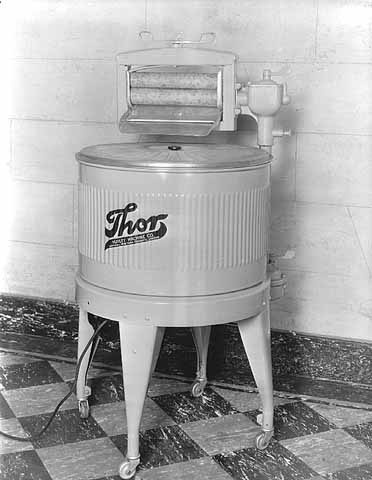
"Thor" brand electric washing machine
"Thor" brand electric washing machine, ca. 1930s. Photographed by Lee Brothers.
Holding Location
More Information
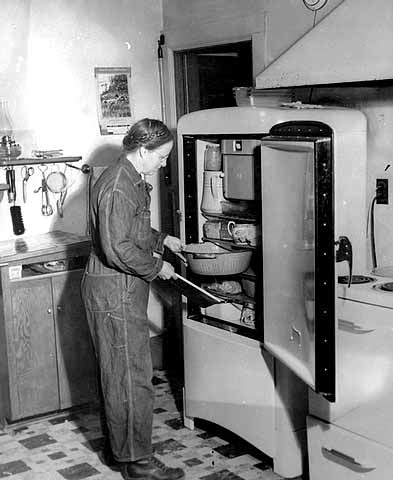
Linda Benitt at the refrigerator in her kitchen
Linda Benitt at the refrigerator in her kitchen, Dakota County, 1944.
Holding Location
More Information
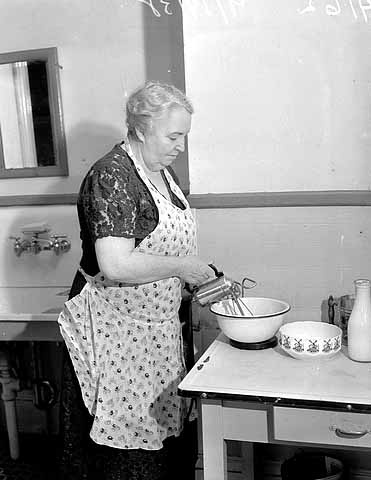
Woman using an electric mixer
Woman using an electric mixer, 1938. Photographed by the Minneapolis Star Journal.
Holding Location
More Information

Woman on a farm ironing
Woman on a farm ironing, ca. 1925.
Holding Location
More Information
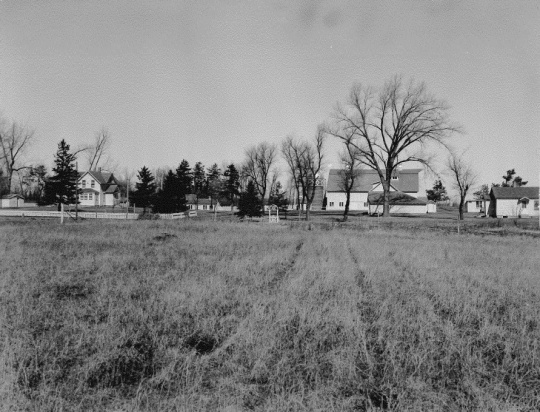
Charles Ness family farm, Meeker County
The Meeker County farm of the Charles Ness family, 1947. As one of just two R.E.A. electric demonstration farms in the U.S., the Ness farm hosted 34,000 visitors from thirty-two states and six foreign countries interested in learning about the benefits of electricity.
All rights reserved
Holding Location
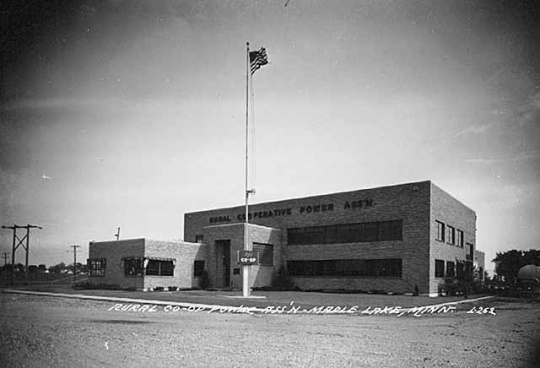
Rural Cooperative Power Association, Maple Lake
Rural Cooperative Power Association, Maple Lake, ca. 1950.
Holding Location
More Information
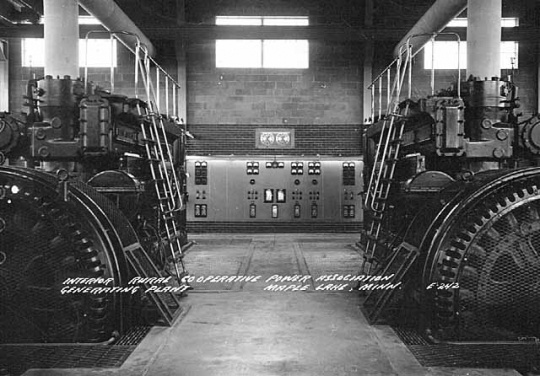
Rural Cooperative Power Association Generating Plant, Maple Lake
Rural Cooperative Power Association Generating Plant, Maple Lake, ca. 1950.
Holding Location
More Information
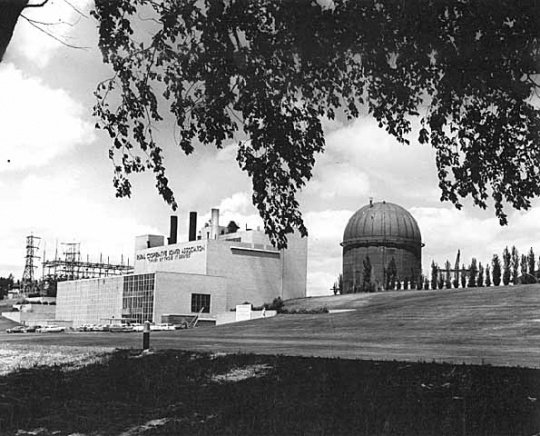
Rural Cooperative Power Association at Elk River
Rural Cooperative Power Association at Elk River, 1960.
Holding Location
More Information
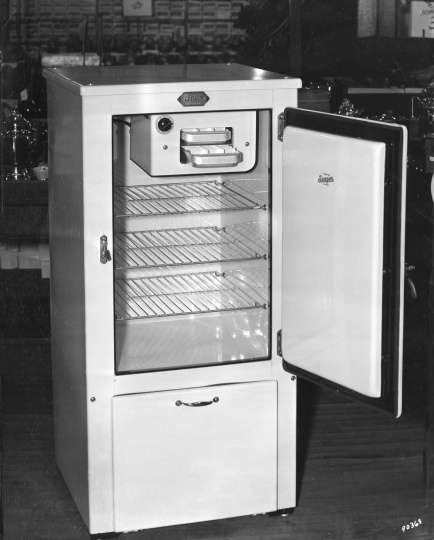
Electric refrigerator
Electric refrigerator, 1931.
Holding Location
More Information
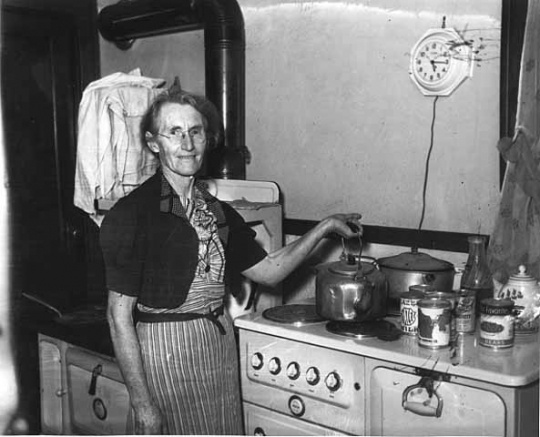
Woman standing by an electric stove
Woman standing by an electric stove, 1940. Photographed by the Minneapolis Star Journal.
Holding Location
More Information
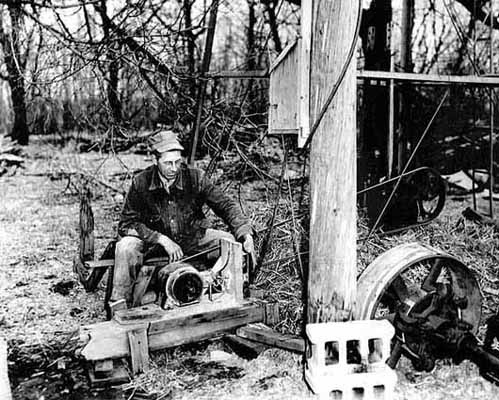
W. A. Benitt with electric pump at the windmill
W. A. Benitt with electric pump at the windmill, 1938.
Holding Location
More Information
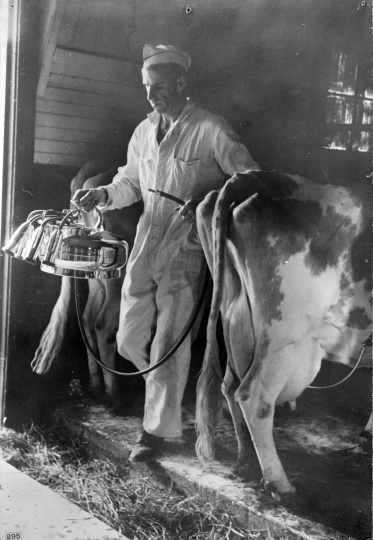
Adjusting a milking machine on a Dakota County dairy farm
Adjusting a milking machine on a Dakota County dairy farm, 1939. Photographed by Arthur Rothstein, Farm Security Administration.
Holding Location
More Information
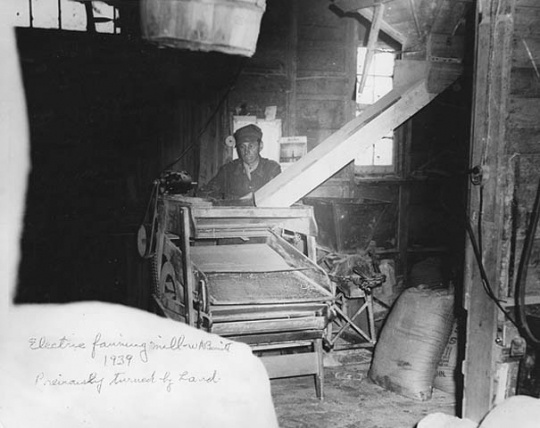
Man operating electric fanning mill
Man operating electric fanning mill, W. A. Benitt farm, Dakota County, 1939.
Holding Location
More Information

Philco model 37-84 electric table radio
Philco model 37-84 electric table radio with arched cathedral-style case, ca. 1930–1939.
All rights reserved
Holding Location
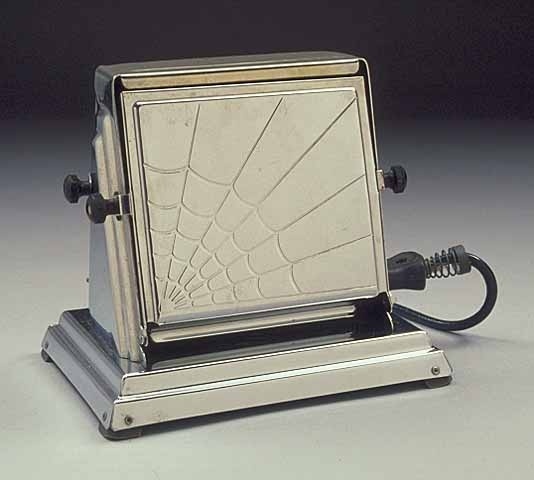
General Electric two-slice toaster
General Electric two-slice toaster and cord, ca. 1930s
All rights reserved
Holding Location
More Information
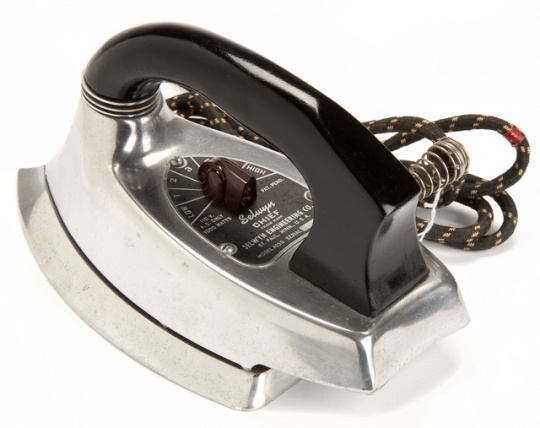
Selwyn Chief iron
Selwyn Chief iron made by the Selwyn Engineering Company of St. Paul, ca. 1930s.
All rights reserved
Holding Location
More Information
Related Articles
Turning Point
On May 11, 1935, President Franklin D. Roosevelt signs Executive Order 7037 to create the Rural Electrification Administration (REA), greatly improving life in rural America.
Chronology
1914
September 1923
November 1923
December 24, 1923
May 11, 1935
September 13, 1935
May 20, 1936
November 28, 1936
1937
1939
Late 1930s
1940
1944
1963
1994
Bibliography
1776–1976, 200 Years of Independence; 1936–1976, 40 Years of Light and Power for Rural America: Rural Electrification Program Booklet. Minneapolis: Minnesota Association of Electric Cooperatives, [1976].
A/.052
Floyd B. Olson Papers, 1923–1974
Manuscript Collection, Minnesota Historical Society, St. Paul
Description: Correspondence, press releases, speeches, clippings, campaign literature, and other materials. Includes information on the Farmer-Labor party, natural resource conservation, agriculture, labor unions, and other topics.
A/.S336
Henrik Shipstead Papers, 1913–1953
Manuscript Collection, Minnesota Historical Society, St. Paul
Description: Correspondence, speeches, scrapbooks, clippings, news releases and related materials concerning Shipstead's career as U.S. senator from Minnesota (1923–1947), including his early sponsorship of rural electrification.
Beall, Robert T. "Rural Electrification." In Yearbook of Agriculture, 790–809. Washington, DC: United States Department of Agriculture, 1940.
McBride, Brandon. “Rural Electrification Celebrates 80 Years of Rural Productivity” USDA (blog). United States Department of Agriculture. May 11, 2015.
http://blogs.usda.gov/2015/05/11/rural-electrification-celebrates-80-years-of-rural-productivity/
Meeker County Light and Power Association.
http://www.meeker.coop/
Minnesota Association of Cooperatives Association Records, 1943–1996.
Manuscript Collection, Minnesota Historical Society, St. Paul
http://www2.mnhs.org/library/findaids/00200.xml
Description: Correspondence and subject files, organizational records, executive director's files, and printed material reflecting organization, membership, and activities of a trade association established in 1946 to promote the interests of cooperative associations.
Minnesota Rural Electric Association.
http://www.mrea.org/
Nass, David. "Bringing Electricity to Minnesota's Farms." Roots 16, no. 1 (Fall 1987): 29–33.
National Academy of Engineering. Electrification History 2 – Rural Electrification.
http://www.greatachievements.org/?id=2990
National Rural Electric Cooperative Association. Rebecca R. Wise, ed. Rural Electric Fact Book. Washington, DC: [1965].
Nelson, Lowry. American Farm Life. Cambridge: Harvard University Press, 1954.
OH141
Oral History Collection, Minnesota Historical Society, St. Paul
http://collections.mnhs.org/cms/display.php?irn=11125269
Description: Oral history interview with Myron R. Allen, conducted by James E. Fogerty and Duane P. Swanson, July 18, 1975.
Pamphlets relating to electric utilities in Minnesota, 1911–
Pamphlet Collection, Minnesota Historical Society, St. Paul
Description: Pamphlets and printed ephemera relating to electric utilities, rural electrification, electrical cooperatives, and related topics.
Runestone Electric Association. REA's History.
http://www.runestoneelectric.com/about_history.cfm
"Rural Electrification Administration." Columbia Encyclopedia, 6th ed. Encyclopedia.com.
http://www.encyclopedia.com/reference/encyclopedias-almanacs-transcripts-and-maps/rural-electrification-administration
Severson, Harold. Bright Lights for a Dark Countryside: the Story of the Electric Power Revolution in Minnesota. Kenyon, Minnesota: Harold Severson, 1977.
——— . The Night They Turned on the Lights. [N.p.]: Midwest Historical Features, 1962.
Stewart, A. A., J. M. Larons, and J. Romness. The Red Wing Project on Utilization of Electricity in Agriculture. St. Paul: University of Minnesota, Division of Agricultural Engineering, 1927.
http://conservancy.umn.edu/handle/11299/48685
United States Department of Agriculture. Briefing on the Status of Rural America. http://www.usda.gov/documents/Briefing_on_the_Status_of_Rural_America_Low_Res_Cover_update_map.pdf
United States Department of Agriculture. Census of Agriculture Historical Archive.
http://agcensus.mannlib.cornell.edu/AgCensus/homepage.do
Urdahl, Dean, and Mary Alice Holm. Leading the Way . . . Lighting the Way, Meeker Cooperative Light and Power Association: Seventy-Fifth Anniversary. Litchfield, MN: Meeker Cooperative Light and Power, 2010.
Related Resources
Primary
Federated Electric Cooperative. Minnesota Rural Electrification Activities! Summary of the Work of the Federated Electric Cooperative During 1935–1936. Minneapolis: The Cooperative, [1936].
General Minnesota Utilities Company Corporate Records, 1927–1952
Manuscript Collection, Minnesota Historical Society, St. Paul
Description: Articles of incorporation, bylaws (1929), rules and regulations (1941, reference books (1952), and miscellaneous information relating to an electric utility company that operated in several north central Minnesota counties from 1929–1954.
Gould, Elizabeth Davis. Rural Electrification in the United States: a Bibliography of Selected References. Washington, DC: U.S. Department of Agriculture, 1954.
National Archives. Guide to Federal Records in the National Archives of the United States. Records of the Rural Electrification Administration [REA].
https://www.archives.gov/research/guide-fed-records/groups/221.html
Records of Floyd B. Olson, Hjalmar Petersen, and Elmer A. Benson, 1932–1938.
State Archives Collection, Minnesota Historical Society, St. Paul
http://www2.mnhs.org/library/findaids/gr00063.xml
Description: General correspondence, subject matter files, state department files, federal department files, and organization files documenting the gubernatorial service of Olson (1931–1936), Petersen (1936–1937), and Benson (1937–1939).
Rural Electrification, State Department of Agriculture, Dairy, and Food, [1941].
Rural Electrification Administration. The Rural Electrification Program Today; Strength for the Future. Washington, DC: Government Printing Office, 1963.
Rural Electrification Statistics: January 1, 1940 to January 1, 1941. MN: Minnesota Division of Rural Electrification, State Department of Agriculture, Dairy and Food, [1941?].
Rural Minnesota News. Alexandria, MN: Rural Publishing Company, 1958–1995.
Secondary
Blegen, Theodore Christian. Minnesota, a History of the State. 2nd ed. Minneapolis: University of Minnesota Press, 1975.
McCarty, Jim. From Darkness to Daylight: How Tri-County Electric Cooperative Brought Power to Southeast Minnesota. Virginia Beach, VA: Donning Company Publishers, 2010.
Pawelk, Sue. Seventy-five Years of Service to the Members of McLeod Cooperative Power Association, 1935 to 2010. Virginia Beach, VA: Donning Company Publishers, 2010.
Thomas, Gwen M. Building the Legacy: East Central Energy, 1936–2011: Celebrating 75 Years Improving the Quality of Life. Virginia Beach, VA: Donning Company Publishers, 2011.
Web
Minnesota Historical Society. Electrifying Minnesota: Suggested Reading and Resources. http://legacy.mnhs.org/traveling-exhibits/electrifying-minnesota-suggested-reading-and-resources
Minnesota Valley Electric Cooperative. Our History.
http://www.mvec.net/about-us/our-history/


















